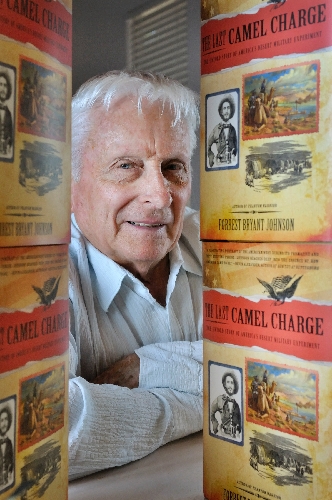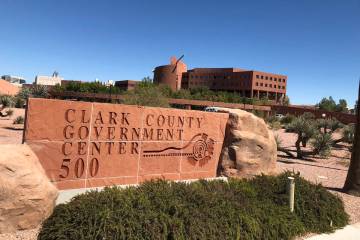Author explores military camel experience
When he was a kid growing up in Kentucky, Forrest Bryant Johnson read a lot of roadside historical markers.
"My father was the kind who would stop whenever he saw a marker," he explains. "Some I found interesting, some I found pretty dumb, but it got into my system to check out these markers."
So when Johnson happened across a weathered historical marker along state Route 163 during a drive from Las Vegas to Laughlin a few years ago, he pulled over to see what it had to say.
It said: Lt. Edward F. Beale, while surveying a wagon road through New Mexico, Arizona and Nevada, crossed the Colorado River near that spot in 1857.
With camels.
Johnson has lived in Las Vegas since the '80s. He's a history buff, and the roster of books he has written include a few military history volumes.
But this camel stuff? That was new to Johnson.
He found it intriguing, though. And now, after spending about two years in research and writing, Johnson shares what he has learned about this odd little chapter of U.S. history in "The Last Camel Charge: The Untold Story of America's Desert Military Experiment" (Berkley Caliber, $25.95).
In the book, Johnson recounts the U.S. military's brief flirtation with seeing whether camels might serve as effective pack animals in the desert Southwest. Along the way, he examines the military, political and social tenor of the time, which included sometimes bloody conflicts between the U.S. government and Native Americans and the U.S. government and Mormons in the Utah Territory, and, off in the distance, the Civil War and technological changes that would make the camel experiment moot.
Because of the multiple threads that make up the fabric of the tale, organizing his material wasn't easy.
"It was like a giant puzzle," he says. "You've got a piece here and you can begin to see the whole picture, but you can write three volumes on this."
Johnson notes, too, that some of the books that have written about the experiment are so laden with detail that the story's gist became lost. The challenge lay in "how to streamline it to keep the reader's attention."
It helps, of course, that the camel experiment was so novel to begin with. The camels' shakedown cruise would take them and their handlers from Texas and through New Mexico, Arizona and the southern tip of Nevada, along a route that would, in part, follow what much later would become Route 66.
Why camels? The notion, Johnson says, was that camels could carry heavier loads than mules or horses, that they could subsist on comparatively less food and water in the desert, and that they were better suited anatomically to a desert environment.
Yet, while camels have been used as pack animals, desert transportation and even for military purposes for a long time, it's amazing, in retrospect, how little their U.S. handlers knew about them.
For instance, Johnson notes that nobody knew whether camels could swim. While awaiting a crossing of a raging Colorado, the trek's camels "saw what happened to the horses and donkeys being swept away and wanted no part of that," Johnson says. "They're very smart animals."
But it turned out the animals could swim, and well, too.
Johnson's story also is populated - as historical events tend to be - by some colorful characters, including:
■ Beale, a naval officer and war hero who was as surprised as anybody when ordered to evaluate what war department officials referred to as a possible "weapon" for the Army;
■ Olive Oatman, who was abducted by Native Americans during an 1851 massacre and later would become namesake of Oatman, Ariz.;
■ Hadji Ali, an immigrant who served the expedition as a camel driver and later, with his name reduced to the nickname "Hi Jolly," became the subject of an American folk song (his camel-topped monument can be seen in Quartzsite, Ariz.).
Ultimately, the U.S. military's camel experiment was abandoned, even though camels, Johnson writes, "had proven themselves to be superior to horses and mules in the desert."
The Civil War was approaching, Johnson explains, and "the people who supported it went off in different directions" including, in some cases - such as Jefferson Davis who, as war secretary, was an early and influential supporter of the camel initiative - to the Confederacy.
And technology was "moving faster," Johnson says. After the war, steam engines and railroads made evaluating the effectiveness of a potentially new desert-crossing medium less necessary. The camel program simply became lost amid the more pressing postwar concerns of rebuilding and reuniting, Johnson says.
However, Johnson notes that, long after the camel experiment's official end, people continued to report seeing wild camels in the desert - in Texas, in Arizona, in California - beginning in the early 1900s and continuing as recently as 2003.
Descendants, perhaps, of the original Army camels that were released during the late 1860s? If nothing else, Johnson agrees, it'd be fun to think so.
Other recently released books either written by Southern Nevada authors or which deal with Southern Nevada themes include:
"Becoming Sister Wives: The Story of an Unconventional Marriage" (Gallery Books, $25) is the story of the family from the TLC reality series "Sister Wives" as told by Kody, Meri, Janelle, Christine and Robyn Brown.
"Bright Lights, Dark Places" (Tate Publishing, $19.99) is Debra Gauthier's memoir of the 21 years she spent as an officer with the Metropolitan Police Department, including the sexism she experienced and, ultimately, her own personal growth.
"Caged Moon" (CreateSpace, $9.99) is Rachel Deagan's young adult paranormal novel about werewolves and other creepy things. (A companion novella, "Alpha Moon," is scheduled for release June 17.)
"Defying Evil: How the Italian Army Saved Croatian Jews During the Holocaust" (History Publishing Co., $17.95) is Eldorado High School history teacher Benjamin Wood's true story about how members of Italy's military and diplomatic corps conspired to save Croatian Jews during the height of World War II.
"Gambling, Space and Time: Shifting Boundaries and Cultures" (University of Nevada Press, $39.95) co-edited by David G. Schwartz, director of the Center for Gaming Research at the University of Nevada, Las Vegas, features essays that explore the continuing evolution of gaming.
"I Get Paid for This: Kicking Ass and Taking Notes In Vegas" by Rick Lax (Huntington Press, $15.95) is Las Vegas writer/"stunt journalist" Rick Lax's latest compilation of offbeat reportage.
"I Wore the Ocean in the Shape of a Girl" (Free Press, $14) is poet and author Kelle Groom's memoir of drug addiction, pregnancy at 19 and losing her baby twice, once to adoption and then to leukemia.
"The Independent Filmmaker's Guide to Writing a Business Plan for Investors" (McFarland, $45) is the second edition of Gabriel Campisi's field guide to finding production capital.
"Landing in Las Vegas: Commercial Aviation and the Making of a Tourist City" by Daniel K. Bubb (University of Nevada Press, $34.95) examines the symbiotic relationship between commercial aviation and Las Vegas' development and growth.
"The Legend of White Eagle" (CreateSpace, $12) is Raymond Shevsky's debut novel about how a man's life is transformed after a chance meeting with a mysterious Native American man.
"The Life and Death of Thelma Todd" by William Donati (McFarland, $39.95) explores the life and mysterious death at age 29 of the beautiful blond actress who appeared in films with such stars as Buster Keaton, Laurel and Hardy, and the Marx Brothers.
"Lords of Las Vegas" (Stephens Press, $19.95) is a political thriller by Kurt Divich about Las Vegas' movers and shakers.
"The Millionaire's Wife: The True Story of a Real Estate Tycoon, His Beautiful Young Mistress and a Marriage that Ended in Murder" (St. Martin's True Crime, $7.99) is Las Vegas author Cathy Scott's latest true crime tale.
"Nevada's Changing Wildlife Habitat: An Ecological History" by George E. Gruell with Sherman Swanson (University of Nevada Press, $39.95) uses archival records and other sources to track how wildlife in the Great Basin has changed over time.
"Passion Realized: Poems for All Occasions" (AuthorHouse, $12.90) is Southern Nevada poet Idella Mullins' latest collection.
"Reverend America" (Dark Coast Press, $16.95) is Kris Saknussemm's comic tale about an albino former preacher and faith healer whose own efforts to heal are complicated by a pregnant teenage prostitute and the pair's own attempt to outrun their pasts on a great American road trip.
"Star Truck: Untold History of the Space Shuttle" by John Getter (CreateSpace, $9.95) shares little-known stories about the space shuttle.
"Sunrise Point" and "Redwood Bend" (Mira, $7.99 each) are the two latest entries in Southern Nevada author Robyn Carr's best-selling "Virgin River" romance series.
Contact reporter John Przybys at jprzybys@reviewjournal. com or 702-383-0280.




























